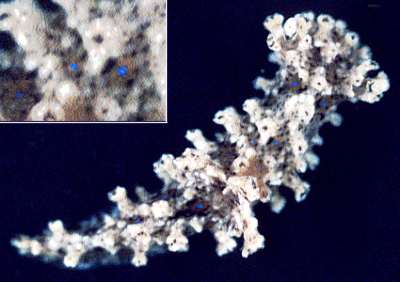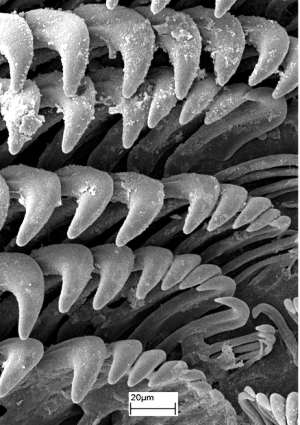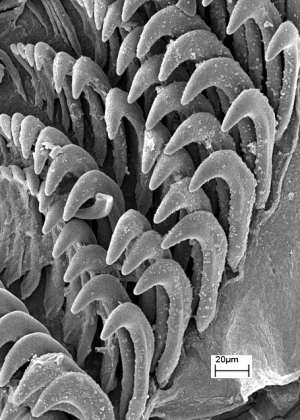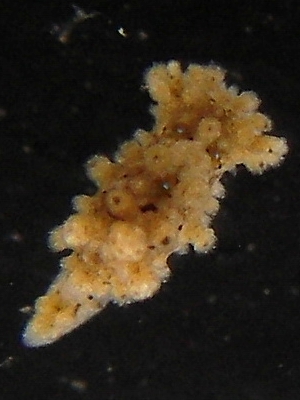
Aegires exeches
Fahey and Gosliner, 2004
Order: NUDIBRANCHIA
Suborder: DORIDINA
Superfamily: ANADORIDOIDEA
Family: Aegiretidae
DISTRIBUTION
Hawaii, Japan, Papua New Guinea, Marshall Islands, Great Barrier Reef, Australia.
PHOTO
Upper right: Aegires exeches. HOLOTYPE: CASIZ 078629, 4 mm, Hekili Point, Maui, Hawaii, 1 m, collected May 1991, C. Pittman. Photo: P. Fiene. Lower photos: SEM of Radula. Scale bar = 20µm. Photos from Fahey & Gosliner (2004).
The dorsum is covered completely with numerous, compound tubercles that are elongate and narrow slightly before mushrooming into flattened plate-like tops. The background color ranges from white to tan-white. The tops of the tubercles on the tan specimens only have dark spots. The rhinophore pockets are very long and composed of two main tubercles on the anterior side, two shorter tubercles on the posterior side and much smaller tubercles in between. The rhinophores are unusual for Aegires in that they have bifid apices. The gill protective appendages are also composed of elaborate tubercles. The gill leaves are very small and inconspicuous. Specimens range from 2–4 mm in length.
Externally, A. exeches most closely resembles A. punctilucens (d'Orbigny, 1837) from the Mediterranean. However, there are both external and internal differences that separate these two species. Externally, the most obvious differences are the body shape, the rhinophoral apices, the gill protective structure morphology and the tubercle arrangement. The body shape of A. exeches is very elongate with extremely elevated, mushroom shaped tubercles that have a flattened crown and completely cover the dorsum. The rhinophores of this species have bifid apices. The gill protective structure is very elaborate and lobed. None of these features are shared with A. punctilucens.
- Fahey, S. J. & Gosliner, T. M. (2004) A Phylogenetic Analysis of the Aegiridae Fischer, 1883 (Mollusca, Nudibranchia, Phanerobranchia) with Descriptions of Eight New Species and a Reassessment of Phanerobranch Relationships. Proceedings of the CaliforniaAcademy of Sciences, 55, (34): 613–689, 82 figs., 4 tables (Appendix).


Fahey, S. J. & Gosliner, T. M., 2005 (July 5) Aegires exeches Fahey and Gosliner, 2004. [In] Sea Slug Forum. Australian Museum, Sydney. Available from http://www.seaslugforum.net/find/aegiexec
Related messages
Nudibranch from intertidal seaweed
April 9, 2007
From: T. Joan Hales

Dear Bill,
I found this tiny 3 mm nudibranch on seaweed at Cape Paterson, Victoria,Australia, 24 February 2007 which is open to Bass Strait. It was from the low intertidal area. On 26 February 2007, I found another from weed at Harmers Haven, Victoria, Australia, which is about 2 kms west of Cape Paterson. I have never seen them before. The photo is not large due to the size of the animal and the limitations of my camera. I think from your website that it is Aegires exeches.
Locality: Cape Paterson, Low tide level, Victoria, Australia, Bass Strait, 24 February 2007, Rock platform. Length: 3 mm. Photographer: T. Joan Hales.
Thanks,
Joan
phasianella@dcsi.net.au
Hales, T. J., 2007 (Apr 9) Nudibranch from intertidal seaweed. [Message in] Sea Slug Forum. Australian Museum, Sydney. Available from http://www.seaslugforum.net/find/19549Dear Joan,
Thanks for this record. As you will see in the messages on the Aegires punctilucens Fact Sheet I am not convinced that A. exeches is a good species. I suspect it is the same as A. punctilucens. If you go to that species, you will find some more records of the species from Australian waters.
Best wishes,
Bill Rudman
